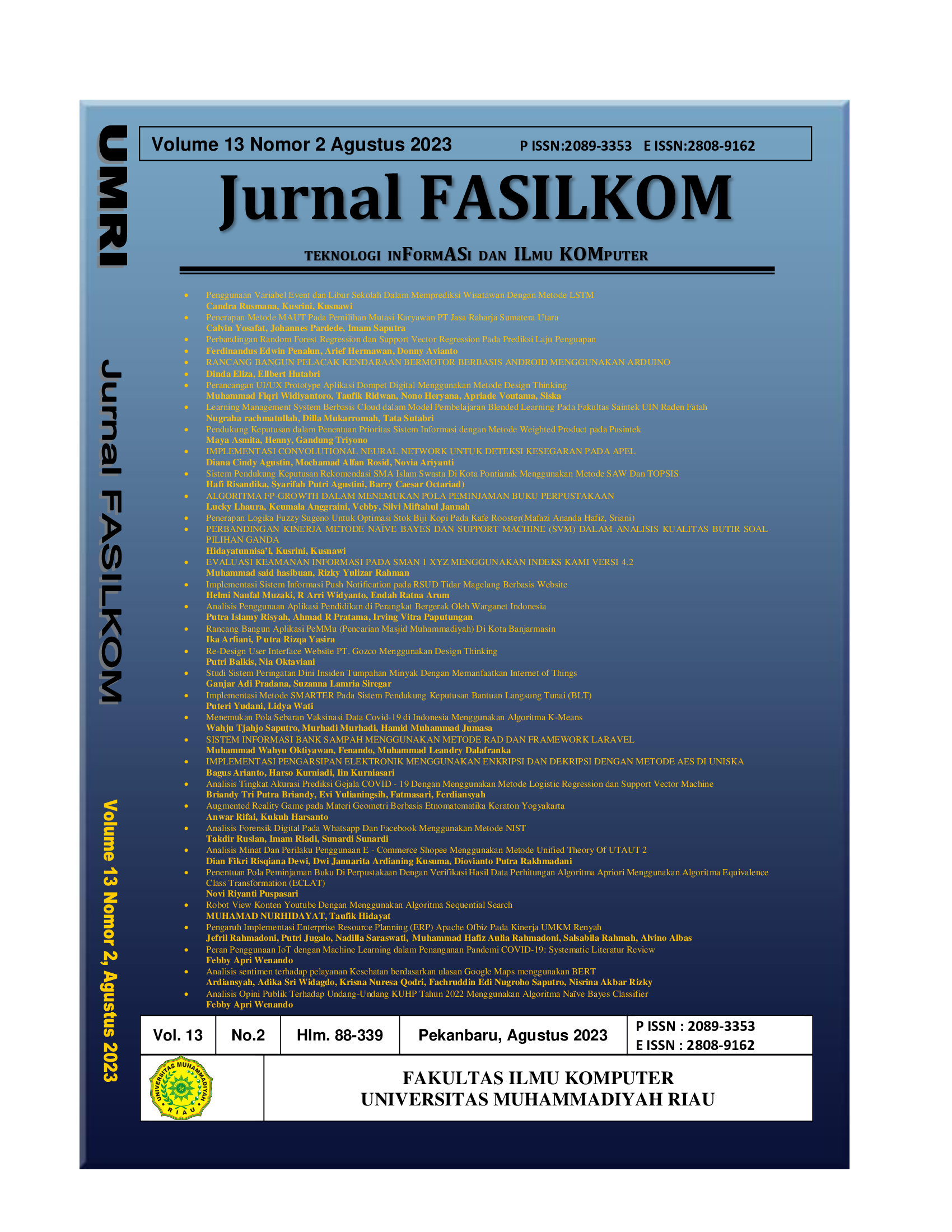Analisis sentimen terhadap pelayanan Kesehatan berdasarkan ulasan Google Maps menggunakan BERT
DOI:
 https://doi.org/10.37859/jf.v13i02.5170
https://doi.org/10.37859/jf.v13i02.5170
Abstract
The utilization of technology has developed in various scientific fields, without exception in health. Hospitals, health centers, and clinics are part of the health sector. Thus, it must evolve according to health service standards and patient measures or service user satisfaction that needs to be measured using sentiment analysis. The Media to give opinions to Health service providers is Google Maps. However, the anomaly is that the reviews and the given text are sometimes not correlated. Thus, The utilization of sentiment analysis using the scientific branch of artificial intelligence, namely Natural Language Processing (NLP), is an effective way to infer opinions. The research concluded that the BERT indobenchmark/indobert-base-p1 model has good performance to use of Indonesian text classification with a dataset of 4228 data after preprocessing, which at the beginning of the collection process obtained data as much as 4748 data. Split datasets into 3 data, namely training, validation, and test data, with a ratio of 70:30:30. The experimental results, The researchers found that the model allows the use of the model with other Indonesian texts. The results are 0.85 for accuracy and weighted avg, and macro avg 0.75 on the validation data training process. While the testing data training process is 0.86 for accuracy and weighted avg, the macro avg 0.73. In addition, researchers found that services are the most frequent topic in Health Services. Even though health services have improved, positive sentiment is the highest compared to other sentiment classes.
Downloads
References
[2] A. M. Abirami and A. Askarunisa, “Sentiment analysis model to emphasize the impact of online reviews in healthcare industry,” Online Information Review, vol. 41, no. 4, pp. 471–486, 2017.
[3] V. I. S. RamyaSri, C. Niharika, K. Maneesh, and M. Ismail, “Sentiment Analysis of Patients’ Opinions in Healthcare using Lexicon-based Method,” Int J Eng Adv Technol, vol. 9, no. 1, pp. 6977–6981, 2019.
[4] F. Nurfitriani and F. Sembiring, “Sistem Pendukung Keputusan Pemilihan Rumah Sakit Menggunakan Metode Simple Additive Weight (Saw),” in Seminar Nasional Sistem Informasi dan Manajemen Informatika Universitas Nusa Putra, 2021, pp. 98–106.
[5] J. D. C. Aruan, B. Rahayudi, and A. Ridok, “Analisis Sentimen Opini Masyarakat terhadap Pelayanan Rumah Sakit Umum Daerah menggunakan Metode Support Vector Machine dan Term Frequency–Inverse Document Frequency,” Jurnal Pengembangan Teknologi Informasi dan Ilmu Komputer e-ISSN, vol. 2548, p. 964X, 2022.
[6] A. R. C. Adi, “ANALISIS KEPUASAN PELAYANAN RUMAH SAKIR MITRA HUSADA PRINGSEWI MENGGUNAKAAN METODE LOGISTIC REGRESSION,” Jurnal Ilmu Data, vol. 2, no. 12, 2022.
[7] E. H. Muktafin, P. Pramono, and K. Kusrini, “Sentiments analysis of customer satisfaction in public services using K-nearest neighbors algorithm and natural language processing approach,” TELKOMNIKA (Telecommunication Computing Electronics and Control), vol. 19, no. 1, pp. 146–154, 2021.
[8] S. Kushwah and S. Das, “Sentiment analysis of big-data in healthcare: issue and challenges,” in 2020 IEEE 5th International Conference on Computing Communication and Automation (ICCCA), IEEE, 2020, pp. 658–663.
[9] J. Godara, R. Aron, and M. Shabaz, “Sentiment analysis and sarcasm detection from social network to train health-care professionals,” World Journal of Engineering, vol. 19, no. 1, pp. 124–133, 2022.
[10] E. Saad et al., “Determining the efficiency of drugs under special conditions from users’ reviews on healthcare web forums,” IEEE Access, vol. 9, pp. 85721–85737, 2021.
[11] D. Georgiou, A. MacFarlane, and T. Russell-Rose, “Extracting sentiment from healthcare survey data: An evaluation of sentiment analysis tools,” in 2015 Science and Information Conference (SAI), IEEE, 2015, pp. 352–361.
[12] G. Saranya, G. Geetha, K. Meenakshi, and S. Karpagaselvi, “Sentiment analysis of healthcare Tweets using SVM Classifier,” in 2020 International Conference on Power, Energy, Control and Transmission Systems (ICPECTS), IEEE, 2020, pp. 1–3.
[13] K. Jindal and R. Aron, “A systematic study of sentiment analysis for social media data,” Mater Today Proc, 2021.
[14] A. S. Aribowo, “Analisis Sentimen Publik pada Program Kesehatan Masyarakat menggunakan Twitter Opinion Mining,” in Seminar Nasional Informatika Medis (SNIMed), 2018, pp. 17–23.
[15] D. Pradipta, K. Kusrini, and H. Al Fatta, “Sentiment Analysis Comments Covid-19 Variant Omicron on Social Media Instagram with Bidirectional Encoder from Transformers (BERT),” JTECS: Jurnal Sistem Telekomunikasi Elektronika Sistem Kontrol Power Sistem dan Komputer, vol. 3, no. 1, pp. 51–58, 2023.
[16] D. Arianto and I. Budi, “Aspect-based Sentiment Analysis on Indonesia’s Tourism Destinations Based on Google Maps User Code-Mixed Reviews (Study Case: Borobudur and Prambanan Temples),” in Proceedings of the 34th Pacific Asia Conference on Language, Information and Computation, 2020, pp. 359–367.
[17] B. Mathayomchan and K. Sripanidkulchai, “Utilizing Google translated Reviews from Google maps in sentiment analysis for Phuket tourist attractions,” in 2019 16th International Joint Conference on Computer Science and Software Engineering (JCSSE), IEEE, 2019, pp. 260–265.
[18] D. Alita and A. R. Isnain, “Pendeteksian Sarkasme pada Proses Analisis Sentimen Menggunakan Random Forest Classifier,” Jurnal Komputasi, vol. 8, no. 2, pp. 50–58, 2020.
[19] T. Mustaqim, K. Umam, and M. A. Muslim, “Twitter text mining for sentiment analysis on government’s response to forest fires with vader lexicon polarity detection and k-nearest neighbor algorithm,” in Journal of Physics: Conference Series, IOP Publishing, 2020, p. 032024.
[20] A. PATEL, P. OZA, and S. AGRAWAL, “Sentiment Analysis of Customer Feedback and Reviews for Airline Services using Language Representation Model,” Procedia Comput Sci, vol. 218, pp. 2459–2467, 2023.
[21] J. A. García-Díaz, F. García-Sánchez, and R. Valencia-García, “Smart Analysis of Economics Sentiment in Spanish based on Linguistic Features and Transformers,” IEEE Access, 2023.
[22] Y. Liu et al., “Roberta: A robustly optimized bert pretraining approach,” arXiv preprint arXiv:1907.11692, 2019.
[23] V. Shanmuganathan, V. H. C. de Albuquerque, P. C. S. Barbosa, M. C. dos Reis, G. Dhiman, and M. A. Shah, “Software based sentiment analysis of clinical data for healthcare sector,” IET Software, 2023.
[24] B. Wilie et al., “IndoNLU: Benchmark and resources for evaluating Indonesian natural language understanding,” arXiv preprint arXiv:2009.05387, 2020.
Downloads
Published
Issue
Section
License
Copyright Notice
An author who publishes in the Jurnal FASILKOM (teknologi inFormASi dan ILmu KOMputer) agrees to the following terms:
- Author retains the copyright and grants the journal the right of first publication of the work simultaneously licensed under the Creative Commons Attribution-ShareAlike 4.0 License that allows others to share the work with an acknowledgement of the work's authorship and initial publication in this journal
- Author is able to enter into separate, additional contractual arrangements for the non-exclusive distribution of the journal's published version of the work (e.g., post it to an institutional repository or publish it in a book) with the acknowledgement of its initial publication in this journal.
- Author is permitted and encouraged to post his/her work online (e.g., in institutional repositories or on their website) prior to and during the submission process, as it can lead to productive exchanges, as well as earlier and greater citation of the published work (See The Effect of Open Access).
Read more about the Creative Commons Attribution-ShareAlike 4.0 Licence here: https://creativecommons.org/licenses/by-sa/4.0/.












_(1).png)





